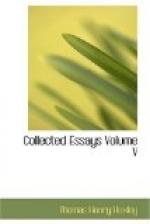[87] See the expression
of orthodox opinion upon the
“accommodation”
subterfuge already cited above, p. 217.
[88] I quote the first
edition (1843). A second edition
appeared
in 1870. Tract 85 of the Tracts for the
Times
should be read with this Essay. If I were
called
upon to compile a Primer of “Infidelity,”
I
think
I should save myself trouble by making a
selection
from these works, and from the Essay on
Development
by the same author.
[89] Yet, when it suits
his purpose, as in the Introduction
to
the Essay on Development, Dr. Newman can demand
strict
evidence in religious questions as sharply as
any
“infidel author;” and he can even profess
to yield
to
its force (Essay on Miracles, 1870; note, p.
391).
[90] Compare Tract 85,
p. 110; “I am persuaded that were men
but
consistent who oppose the Church doctrines as being
unscriptural,
they would vindicate the Jews for
rejecting
the Gospel.”
[91] According to Dr.
Newman, “This prayer [that of Bishop
Alexander,
who begged God to ‘take Arius away’] is
said
to
have been offered about 3 P.M. on the Saturday; that
same
evening Arius was in the great square of
Constantine,
when he was suddenly seized with
indisposition”
(p. clxx). The “infidel” Gibbon seems
to
have
dared to suggest that “an option between poison
and
miracle” is presented by this case; and it must
be
admitted,
that, if the Bishop had been within the reach
of
a modern police magistrate, things might have gone
hardly
with him. Modern “Infidels,” possessed
of a
slight
knowledge of chemistry, are not unlikely, with
no
less audacity, to suggest an “option between
fire-damp
and miracle” in seeking for the cause of the
fiery
outburst at Jerusalem.
[92] A writer in a spiritualist
journal takes me roundly
to
task for venturing to doubt the historical and
literal
truth of the Gadarene story. The following
passage
in his letter is worth quotation: “Now to
the
materialistic
and scientific mind, to the uninitiated
in
spiritual verities, certainly this story of the
Gadarene
or Gergesene swine presents insurmountable
difficulties;
it seems grotesque and nonsensical. To
the
experienced, trained, and cultivated Spiritualist
this
miracle is, as I am prepared to show, one of the
most
instructive, the most profoundly useful, and the
most
beneficent which Jesus ever wrought in the whole
course
of His pilgrimage of redemption on earth.”
Just
so.
And the first page of this same journal presents
the
following advertisement, among others of the same
kidney:




